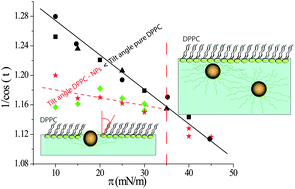Polymer-capped magnetite nanoparticles change the 2D structure of DPPC model membranes†
Abstract
The interaction of biocompatible and stimuli-responsive Fe3O4

* Corresponding authors
a
Max Planck Institute of Colloids and Interfaces, Science Park Potsdam-Golm, Am Muehlenberg 1, D-14476 Potsdam, Germany
E-mail:
stefaniu@mpikg.mpg.de
The interaction of biocompatible and stimuli-responsive Fe3O4

 Please wait while we load your content...
Something went wrong. Try again?
Please wait while we load your content...
Something went wrong. Try again?
C. Stefaniu, G. Brezesinski and H. Möhwald, Soft Matter, 2012, 8, 7952 DOI: 10.1039/C2SM25773D
To request permission to reproduce material from this article, please go to the Copyright Clearance Center request page.
If you are an author contributing to an RSC publication, you do not need to request permission provided correct acknowledgement is given.
If you are the author of this article, you do not need to request permission to reproduce figures and diagrams provided correct acknowledgement is given. If you want to reproduce the whole article in a third-party publication (excluding your thesis/dissertation for which permission is not required) please go to the Copyright Clearance Center request page.
Read more about how to correctly acknowledge RSC content.
 Fetching data from CrossRef.
Fetching data from CrossRef.
This may take some time to load.
Loading related content
